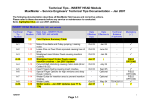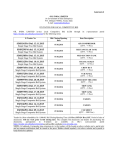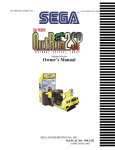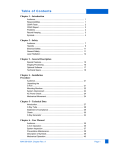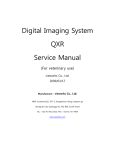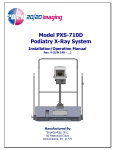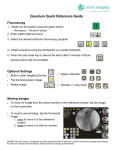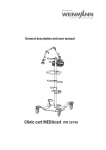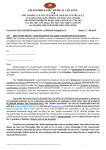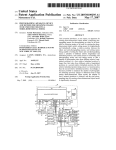Download - Frank`s Hospital Workshop
Transcript
Ziehm 7000 Plus Ziehm Compact Ziehm Vista Plus Ziehm Vario CDRH Maintenance Report CDRH Maintenance Report 28143 - 01/2006 1 2 CDRH Maintenance Report 28143 - 01/2006 CDRH Maintenance Report This is a master copy of Ziehm's CDRH Maintenance Report for the Ziehm 7000 Plus, Ziehm Compact, Ziehm Vista Plus and Ziehm Vario CArm. Make photocopies and safeguard it and for future use. You are required by the Food and Drug Administration (FDA) to perform the checks and inspections described in this document, at least every six months, in order to ensure that the x-ray system complies with federal regulations (specifically, the applicable sections of CFR 21, Subchapter J - Radiological Health). Introduction The equipment user is responsible for ensuring that the maintenance steps described in this procedure every six months. Failure to comply with this requirement relieves the Manufacturer and his agents of all responsibility in this matter. Responsibilites The equipment user is responsible for ensuring that only service technicians certified by the manufacturer perform the tests and adjustments described in this procedure. Service technicians are responsible for performing this procedure in the sequence shown. Please provide the following information: Company information Company Name: Phone Number: Address: C-Arm Model: C-Arm Serial Number: Location/Room Number: Name of Technician: Table 1 Company information CDRH Maintenance Report 28143 - 01/2006 3 Equipment The following equipment and material is required to perform this procedure: − Digital multi meter (e.g., Fluke 8040A, Fluke 87 or Equivalent) − Dosimeter kit (Calibrated Radiation Dose Meter) − Beam center target, 40-400-T10 − Storage oscilloscope − Fluorescent cross, 44-14-538 RH090 − Vinyl lead sheets (3 mm lead blocker) Reporting To FDA 1 Once the following system compliance test are completed. You must complete the FDA 2579 HEW report and provide copy to the Facility, copy to the local State, copy to FDA, and one copy to the Manufacture. This must be completed with in 15 days of the install date. Form is available form the FDA. Introduction Throughout this procedure you will be required to measure several equipment operating values and record your measurements. Checks or adjustments that require radiation exposure are marked with the radiation symbol displayed on the right, to alert you to follow all applicable safety codes and regulations. CAUTION Make sure that you follow all safety rules regarding the use of radiationemitting equipment. 2 Safety − Make all earth-lead connections provided by the manufacturer. For example, equipment metal panels may expose you to dangerous voltages, unless they are grounded. Therefore, ground metal panels. − Use a digital multi meter to check each ground lead connections. Measure from ground point to outside cover, to ensure that positive grounding has been achieved. − Follow all occupational safety laws and state codes that pertain to your installation site. 4 CDRH Maintenance Report 28143 - 01/2006 − If there has been an accident, or if there are hazards which may result in an accident, immediately notify your supervisor. − Raise the C-Arm high enough to allow the C to rotate freely without interference from the C-Arm base or floor. Verify that the C-Arm is high enough and that the control locks work properly with the C-Profile in various positions. 3 Necessary documentation Verify that the following documents were delivered to the customer. Document Documents Received? Operating Instructions Yes No Maintenance Instructions Yes No Table 2 Necessary documents If the customer cannot locate any of these documents, make arrangements to have the missing documents replaced immediately. 4 Image intensifier Inspect the image intensifier to determine if there are any mechanical faults (e.g., broken or missing covers). If there is a mechanical fault, write a description of the fault below and contact Ziehm Imaging, Inc. 5 Labeling Verify that the certification and warning labels are present and legible. Record the model number and serial number in the table below. If labels are required, contact Ziehm Imaging, Inc. Service department. Check Labels Refer to the product user manual for label location and identification. Inspect the C-Arm and verify that the certification, serial number, and model labels are present and legible. Record the model number and serial number in the box below. CDRH Maintenance Report 28143 - 01/2006 5 Certified Component Labels Model No. Serial No. Pass/Fail C-arm mobile stand X-ray control panel Image intensifier assembly X-ray generator Image system Laser LG Laser LC Table 3 6 Label data Check the dead man switch The purpose of this test is to verify that the system immediately stops emitting radiation once the hand switch or the foot switch are released. If either of the switches fails this test, contact Ziehm Imaging, Inc. Service Department. 6.1 Radiography At the mobile stand control panel, set exposure time to four seconds and kV to 40. • Press and release the hand switch and verify that radiation stops immediately after releasing the hand switch. 6.2 Fluoroscopy • At the mobile stand control panel, select Fluoroscopy mode. • Turn off Noise Reduction and Last Image Hold (LIH). • Press and the hand switch for a few seconds. Release and verify that radiation stops immediately after releasing the hand switch. • Repeat the last step using the foot switch. Record the results of this test in the box below. If radiation does not stop immediately, contact Ziehm Service. Dead man switch Table 4 6 Accept Reject Dead man switch CDRH Maintenance Report 28143 - 01/2006 7 Check radiation indicators • Activate Radiography and verify that the radiation control indicator on the mobile stand control panel lights-up. • Activate Fluoroscopy and verify that the radiation control indicator on the mobile stand control panel lights-up, and that the yellow radiation light on the monitor cart lights-up. Radiation lights working? Table 5 8 Yes No Check radiation indicators Check fluoroscopy time (see 21 CFR 1020.31 (a)) • Set manual fluoroscopy voltage to 40 kV. • Close the iris diaphragm and cover the tube assembly with a lead apron. • Switch on fluoroscopy. • Verify that the audible alarm sounds once the system has reached five minutes of fluoroscopy. • Press the Zero Min button to turn off the alarm. The time will continue to be displayed flash. • To turn off both the alarm and the LED, press and hold the Zero Min >2 Sec button. Fluoroscopy time in order? Table 6 Yes No Check fluoroscopy time CDRH Maintenance Report 28143 - 01/2006 7 9 Check kV values Fig. 1 Generator components • Turn off the system and disconnect the power cord from the wall power supply. • Remove the tube head cover. • Set an oscilloscope to 2.0 volts on the DC scale (1 V = 10 kV). Connect the oscilloscope to TP OV and TP f (→ fig. 1, p. 2-8) or use a non Invasive kVp meter and place it in the beam above the generator following the manufactures instruction for measuring kVp. • Connect the system power cord to the wall power supply and turn on the system. • Select Radiographic exposure. • Press the manual kV button. • Set the timer to 0.4 seconds and kVp voltage to 50 kV. • Press the hand switch and make an exposure. • Observe the kV value displayed on the oscilloscope and write the value below. • Set the timer to 0.4 seconds and 110 kV. • Press the hand switch and make an exposure. 8 CDRH Maintenance Report 28143 - 01/2006 • Observe the kV value displayed on the oscilloscope and write the value below. 50kVp 110kVp Table 7 KV values • If kV value displayed by the oscilloscope is > 10% of 50 kV or 110 kV, then the generator's U326 board must be adjusted. Adjusting the U326 Board • Set kV manually to 75 kVp. • Press the hand switch and make an exposure. Adjust P1 on the U326 board until the kV value displayed on the oscilloscope is 7.5 V or NonInvasive meter displays 75kVp. • Repeat all steps for checking the kV values described above. Note For more information, refer to U326 Board Service Calibration Instructions in the Service/Technical Manual for the model being tested. 10 Check Tube Current Tube current must be checked in each of the three fluoroscopic modes: − Extremities − Head, Spinal Column, and Pelvis − Thorax Rejection Criteria: − At 0.2 to 1.2 mA, reject if mA readings on multimeter and control panel display are different by 15% or greater. − At 1.3 to 8.0 mA, reject if mA readings in multimeter and control panel display are different by 10% or greater. • Turn off the system and disconnect the power cord from the wall power supply. • Remove the tube head cover. • Remove the mA bridge (→ fig. 1, p. 2-8) and insert a mAs multimeter probe in place of the jumper. CDRH Maintenance Report 28143 - 01/2006 9 • Adjust the mA multimeter to the lowest scale that displays a full 40 mAs. • Connect the system power cord to the wall power supply and turn on the system. • Select the Extremities mode, and press the hand switch or foot switch. • Observe the mA value displayed on the multimeter and compare to the value shown in the control panel display. If the difference between the values equals or exceeds the rejection criteria, then the U326 board must be re-calibrated. • Write the mA value displayed by the multimeter in the box below. • Repeat the last 4 steps for the other two fluoroscopic modes. kVp Extremities Pelvic Thorax LPD 50kVp 110kVp Table 8 11 Tube current Check Radiographic Tube Current Rejection Criteria: The mA value must be within 10% of the fixed 20 mA radiography value. • Turn off the system and disconnect the power cord from the wall power supply. • Remove the tube head cover. • Remove the mA bridge (→ fig. 1, p. 2-8) and insert a multimeter probe in place of the jumper. • Adjust the multimeter to the lowest scale that displays a full 40 mAs. • Connect the system power cord to the wall power supply and turn on the system. • Select 75 kVp and 3 seconds of exposure time. • Press the hand switch to release exposure. • Observe the mA value displayed by the multimeter and write this value into the box below. 10 CDRH Maintenance Report 28143 - 01/2006 Radiography mA value Table 9 Radiographic tube current • If mA value displayed by the multimeter is > 10% of 20 mA, then the U326 board must be adjusted. 12 Check Reproducibility The purpose of the following test is to ensure that the system consistently produces a dose level that is within FDA tolerances, for every technique factor. This test consists of taking a set of four exposures, for each technique factor, within a sixty-minute time period. Make sure that: − the dosimeter is calibrated and working properly − measurements are made one-after-another − exposure technique are changed and reset after each measurement − all measurements are made within 60 minutes, from start to finish, and − that you do not exceed tube loading. Dosimeter Information Write the following information regarding your dosimeter into the box below. Dosimeter number: Manufacturer: Model Number: Serial Number: Chamber Serial Number: Date of last calibration: Table 10 Dosimeter information Coefficient of variation For any specific combination of selected technique factors, the estimated coefficient of variation of radiation exposure must not exceed 0.045. The FDA has established the following: "All variable controls for technique factors shall be adjusted to alternate settings and reset to the test setting after each measurement. All values for percent line voltage CDRH Maintenance Report 28143 - 01/2006 11 regulation shall be within + 1 of the mean value for all measurements." (See 21 CFR 1020.31 (b) (2)). • Make sure that the available power supply meets the voltage requirements stated in Chapter 5 - Technical Data. • Place a dosimeter probe in the center of the x-ray path, 70 cm from the focal spot, as shown in Fig. 2. Fig. 2 Dosimeter probe placement • Select Radiographic Mode. Cover the intensifier input with 3 mm of lead blocker. • Set-up the x-ray system as follows: kV = 60, mA = 20, ms = 200. • Take an exposure. Write the resulting dose value into the box below, on line one, dose reading one, and reset the dose meter indicator to zero. • Repeat the previous step three times, writing the resulting dose values into line one of the table below. • Change kV to 90. • Take an exposure. Write the resulting dose value into the box below, on line two, dose reading one, and reset the dose meter indicator to zero. • Repeat the previous step until all 10 exposures have been taken, writing the resulting dose values into each of the 10 points on the table below. 12 CDRH Maintenance Report 28143 - 01/2006 Dose [mR] Line kV mA 60 90 Table 11 20 20 ms 1 2 3 4 5 6 7 8 9 10 AVG 200 200 Coefficient of variation Calculating the coefficient c for n individual measurements, the variation of the coefficient c is obtained from: S = calculated standard deviation X = average value of all individual measurements Xi = measured value of the ith measurement n = number of individual measurements ∆ ∆ = difference 2 Table 12 = difference squared Calculating the Coefficient c • Calculate the average: Add the four dose values and divide the sum by four. X1 + X2 + X3 + X4 ------------------------------------------------= X ( Average ) n • Calculate the difference: Subtract each measured value from the average. Xi - X = ∆ (Difference) • Calculate the difference squared: Multiply the difference by itself. (Xi - X)2 = ∆2 Measurement Table 13 Radiation Exposure Average (X) = Difference Difference Squared Calculated values • Calculate the square root: Add the sum of the four differences squared and divide by 3. Write the result below. Sum = Table 14 Sum divided by 3 = Square root S= CDRH Maintenance Report 28143 - 01/2006 13 • Calculate the variation coefficient: Divide the sum by the average value. Variation coefficient C = S/X = _____________/______________ C = _________________________________ ∆<0.045 Table 15 Accept Reject Variation coefficient If the calculated value of the variation coefficient is greater than 0.045, determine the cause and take corrective action. 13 Beam Quality Test Procedure Fig. 3 Setting-up for beam quality test Refer to 21 CRF 1020.30 (m) - Half Value Layer • Check the calibration of mA, kV, and mAs. • Select Radiography and set to 110 kVp. • Set time to 2.0 seconds to obtain 40 mAs. • Use the 6.0 cc chamber and collimate the beam so that it just covers the sensitive volume of the dose probe (→ fig. 3, p. 2-14). 14 CDRH Maintenance Report 28143 - 01/2006 • Place a dose probe chamber in the center of the beam, 70 cm from the focal spot (→ fig. 3, p. 2-14). • Block input to the image intensifier with 3 mm of lead blocker (→ fig. 3, p. 2-14). • Initiate exposure. Determine the exposure value (R) and write this number into the first row of the Exposure Data column, in the table below. • Add filter material. Write the thickness of the added filter material into the next row of the AL Filtration column. • Determine the exposure value (R) and write this number into the next row of the Exposure Data column. • Repeat the two previous steps at four more times. Thickness (mm) of AL Filtration Table 16 Exposure Data Exposure data • Plot the exposure data, as shown below. Fig. 4 Exposure data plot CDRH Maintenance Report 28143 - 01/2006 15 − Under the first data point (600 in Fig. 4), place a data point that is onehalf the value. In this case, 300. − Draw a horizontal line from the data point to the curve. − Draw a vertical line from the point of this intersection to the horizontal axis (see Fig. 5). Fig. 5 Plotting the half-value layer This halving thickness is the half-value layer (HVL) of the useful x-ray beam. The HVL must not be less than 3.0 mm at 110 kVp. If the HVL is lower that 3.0m, determine the cause and take corrective action. 14 Check Exposure Times • Connect an oscilloscope to test point F on the U54 board (→ fig. 1, p. 2-8) • Place 3 mm of lead in the path of the x-ray beam, to block radiation to the image intensifier. • Set the kV to 60 kV, and time to 0.4 seconds. • Press the hand switch to release radiation. • Read the exposure time on the oscilloscope (start from the beginning of a positive wave to the end of the negative wave that follows), and write the exposure time below. 16 CDRH Maintenance Report 28143 - 01/2006 • Set the time to one second, make another exposure, and write the time below. Exposure time 0.4 sec._____________ 1 sec.____________ms Table 17 If the variation in exposure time is greater than 10%, determine the cause and take corrective action. 15 Check Maximum Dose Rate During Fluoroscopy Federal regulations (21 CFR 1020.32 (d) (1)) establish that fluoroscopic equipment with automatic dose rate control shall not be operable at any combination of tube potential and current which will result in an exposure rate in excess of 10 roentgens-per-minute at the point where the center of the useful beam enters the patient. Federal Regulations • Position a dosimeter probe as shown in Figure 9. Fig. 6 Set-up of maximum dose rate test • Select full image intensifier format. • Fully open the collimator. • Cover the image intensifier input with 3 mm of lead blocker. • Select Extremities and initiate fluoroscopy with the foot switch. Write the resulting dose rate in the box below. CDRH Maintenance Report 28143 - 01/2006 17 • Select Pelvic and initiate fluoroscopy with the foot switch. Write the resulting dose rate in the box below. • Select Thoracic and initiate fluoroscopy with the foot switch. Write the resulting dose rate in the box below. Extremities Entrance dose rate = R____________________(min) Pelvic Entrance dose rate = R____________________(min) Thoracic Entrance dose rate = R____________________(min) Table 18 Entrance dose rate values Reject if entrance dose rate is greater than 9.9 R/min. • Write the model number and serial number of the dosimeter in the box below. Dosimeter Model No.: Dosimeter Serial No.: Table 19 Dosimeter data • Answer the question in the following box. Did X-ray production cease immediately when the hand and/ or foot switch was released? Table 20 16 Yes X-ray production Check the Central X-Ray Beam Federal Regulation Federal regulations (21 CRF 1020.31 (e) (1)) establish that the radiation field must be centered on the image receptor within a tolerance of less that 2% of the Source-to-Image-Distance (SID). The central x-ray is checked through the monitors. • Attach the beam alignment target (p/n 40-400-T 10) to the image intensifier. • Fully open both the slot collimator and iris diaphragm. • Select the full image intensifier format (i.e., no zoom). • Place the C-Arm in the Basic position, shown in Fig. 7. 18 CDRH Maintenance Report 28143 - 01/2006 Fig. 7 C-Arm in the basic position • Initiate fluoroscopy with the foot switch. • While watching the monitor, slowly close the iris until the edges of the iris are visible on the monitor. • Evaluate the position of the central beam as shown in Fig. 8. A = mid-point of the image intensifier input B = middle of the radiation field A = deviation of A to B • Write the actual deviation in the box below. Fig. 8 Evaluating the central X-ray beam • Place the C-Arm in the Left position, shown in Fig. 9, and repeat the previous 4 steps. • Write the actual deviation in the box below. CDRH Maintenance Report 28143 - 01/2006 19 Fig. 9 C-Arm in left position • Place the C-Arm in the Left position, shown in Fig. 9, and repeat the previous steps again. • Write the actual deviation in the box below. Average Deviation Max. Permissible Actual Avg. Deviation Basic Left Right = 5.0 mm = 20.00 mm = 20.00 mm ________________mm ________________mm ________________mm Table 21 Deviation data Values are relative to the monitor. At the C-Arm, full image intensifier format is selected. Note If actual deviations are larger than the amount permissible, make adjustments according to section 17.0. 17 Adjusting Central X-Ray in Relation to the Image Intensifier • Place the C-Arm in the basic position. • Attach the beam center target to the image intensifier (part number 10-400-T 10). • Initiate fluoroscopy by pressing the foot switch. • Adjust the iris collimator to approximately 10 cm in diameter. • Manually reduce kV until the target's markings can be clearly seen. 20 CDRH Maintenance Report 28143 - 01/2006 • Release the foot switch to stop fluoroscopy. The fluoroscopic image received by the image intensifier will be displayed on the monitor, and will show the target and iris openings. • Observe the position of the iris collimator opening on the screen. If the image is not centered to the beam target, proceed to section 18.0. If the image is centered on the beam target, then no further adjustment is necessary. Fig. 10 18 Position of the iris collimator Tube Head Adjustment for Central X-Ray Beam • Turn off the system and disconnect the power cord from the wall power supply. • Remove the tube head cover. • Remove the filter bracket assembly (item 2, Fig. 11) by removing the two four-millimeter screws that secure it (item 3, Fig. 11). 2 = Filter assembly 3 = Filter mounting screws 4 = Lead-lined cover, 17 mm mounting bolts 5 = Allen mounting bolts 6 6 = Allen set screws Fig. 11 Tube Head Adjustment CDRH Maintenance Report 28143 - 01/2006 21 • Carefully move the filter assembly aside to grant access to the area directly below it. CAUTION The filter assembly has 300 volts of direct current, when energized. Be careful! • Remove the lead-lined cover (item 4, Fig. 11) by removing the two nuts that secure it. Inclination Adjustment • Inclination is controlled through two screws and two bolts identified in Fig. 11 and Fig. 11 as items 6, 6A, and 6B. − Item 6A adjusts central inclination − Item 6B secures the central inclination position − Items 6 secure the generator to the moveable C • Loosen items 6 and 6B (refer to Fig. 12). Fig. 12 Inclination Adjustment of the Tube Head • Turn item 6A to achieve the required inclination alignment. • Tighten item 6B to secure the inclination position 22 CDRH Maintenance Report 28143 - 01/2006 Side-to-Side Adjustment • Side-to-side adjustment of the tube head is controlled through two bolts identified in Fig. 13 as item 5. Fig. 13 Side-to-Side Adjustment of the Tube Head • Loosen both bolts and position the tube head to achieve the required alignment. • Tighten the bolts, being careful not to over-tighten. • Reinstall the lead-lined cover (item 4, Fig. 11). • Reinstall the filter bracket assembly (item 2, Fig. 11). • Reinstall the tube head cover. • Connect the power cord to the wall power supply and turn on the Ziehm Quantum. • Perform the steps for adjusting central X-ray in relation to the image intensifier as described in → ch. 17, p. 2-20. 19 Check Collimation Federal Regulation Federal regulations (21 CRF 1020.32 (b) (2) (1)) establish that, during fluoroscopic operation, the x-ray field in the image indicator plate must not exceed 3% of the SID of the visible image-indicator surface - in length or width. The sum of the lengths and widths access may not be greater than 4% of the SID. • Place the C-Arm in the basic position. • Select the full image intensifier input format (i.e., no zoom). • Open the iris diaphragm to the maximum setting. • Initiate fluoroscopy by pressing the foot switch. CDRH Maintenance Report 28143 - 01/2006 23 If all six of the iris diaphragm leaves are visible at the edge of the monitor (as shown in Fig. 14) then no further tests are required. If all six of the iris diaphragm leaves are not visible in the monitor, proceed to the next step: Video display monitor Leaves, iris collimator Fig. 14 Iris collimator leaves still visible in monitor • Attach a light cross, or a fluorescent screen, to the middle of the image intensifier input. • Open the iris diaphragm to the maximum setting. • Initiate fluoroscopy by pressing the foot switch. • The light cross has four measuring sliders: two that move longitudinally, and two that move latitudinally. Move both of the longitudinal sliders inwards, until they are just visible at the edge of the monitor. • Release the foot switch to stop fluoroscopy. • Mark the position of the sliders on the light cross. (With a fluorescent screen, mark the edge of the radiation field). • Initiate fluoroscopy by pressing the foot switch. • Move both of the latitudinal sliders inwards, until they are just visible at the edge of the monitor. • Release the foot switch to stop fluoroscopy. • Mark the position of the sliders on the light cross. (With a fluorescent screen, mark the edge of the radiation field). • Measure the deviations of A1, B1, C and D (see Fig. 15). 24 CDRH Maintenance Report 28143 - 01/2006 Fig. 15 X-Ray field observed on monitor • Calculate the length deviation. L= ∆A+ ∆C • Calculate the width deviation. W= ∆B+ ∆D • Calculate the sum of the length and width deviation. ∆A+ ∆B+ ∆C+ ∆D • Calculate the percent deviation of the length, width, and length combined with width, by multiplying their deviations by 100, and dividing the results by the SID, 97 cm, or 38.2 inches. Write the results in the box below. Image Intensifier Format Length deviation ____________cm __________% <2.4% Width deviation ____________cm __________% <2.4% Length + Width deviation ____________cm __________% <3.2% Table 22 Image intensifier format Zoom Format Length deviation ____________cm __________% <2.4% Width deviation ____________cm __________% <2.4% Length + Width deviation ____________cm __________% <3.2% Table 23 Zoom format If deviations are greater than 3.2%, adjust the control system or collimator alignment until a deviation of less than 3.2% is achieved. CDRH Maintenance Report 28143 - 01/2006 25 20 Adjust the Image Intensifier Format Image Intensifier Format • Open the iris diaphragm to the maximum setting. • Initiate fluoroscopy by pressing the foot switch. • All six of the iris diaphragm leaves must be visible at the edge of the monitor (as shown in Fig. 14). If this is not the case, then the iris control must be adjusted in normal mode, per the Service Manual. 21 Adjust the Zoom Format • Follow the steps in → ch. 20, p. 2-26. 22 Cassette Format Federal Regulation Federal regulations (21 CRF 1020.31 (g) (2)) establish that, if full coverage of the selected part of the image indicator has been set, then the total deviation of the edges of the x-ray field from the corresponding edges of the selected part of the image indicator, may not exceed 3% of SID in the plane of the image indicator in either length or width of the xray field. The absolute sum (disregarding the sign) of the deviation in all orthogonal dimensions may not exceed 4% of the SID. Note In Radiographic mode, the iris collimator limits the cassette format. • Select Fluoroscopy. • Insert film into the cassette (14 x 14 inches). • Lay the cassette onto the image intensifier and fully open the iris diaphragm. • Select Radiography. • Set kV to 60. • Set radiographic exposure time long enough to fully expose the film without over-exposing. • Initiate fluoroscopy by pressing the hand switch. 26 CDRH Maintenance Report 28143 - 01/2006 • When the exposure is finished, release the hand switch. • Develop the film and measure the exposed x-ray field, as shown in Fig. 16. Write the results in the box below. Fig. 16 Measuring the exposed X-Ray field cassette 35 × 35cm (14"×14") Exposed X-ray field: Table 24 Length (A)______cm Width (B)_______cm Exposed X-ray field Cassette to X-Ray Field The following tests must be conducted with the C-Arm in the three positions as described in → ch. 16, p. 2-18. • Select Fluoroscopy. • Place the C-Arm in the basic position. • Insert film into the cassette (10 × 12 inches). • Lay the cassette onto the image intensifier and fully open the iris diaphragm. • Select Radiography. • Set kV to 60. • Set exposure time long enough to fully expose the film without overexposing. • Initiate an exposure by pressing the hand switch. • When the exposure is finished, release the hand switch. • Develop the film and measure the shading of the film edge as shown in Fig. 8. Write the results in the box below. CDRH Maintenance Report 28143 - 01/2006 27 Fig. 17 Measuring the cassette to the X-ray field • Repeat all steps with the C-arm in the left and right positions. C-arm in basic position Shading Table 25 ∆ A_______+ B___________ = mm <21.6 mm C-arm in basic position C-arm in left position Shading Table 26 ∆ A_______+ B___________ = mm <21.6 mm C-arm in basic position C-arm in right position Shading Table 27 ∆ A_______+ B___________ = mm <21.6 mm C-arm in basic position SID 97 cm A*=A-a Reject if A + C > 23.28 mm (2.4% SID) 23 Check the Smallest Field Size Smallest field size The smallest field size should be no larger than 5 × 5 cm, at the image intensifier input. • Load film into a film cassette, and place the cassette on the image intensifier. • Enter the Integrated Service Functions mode, and select Program 1. • Record the current setting for later restoration, and close the iris completely. • Save this setting and exit the Integrated Service Functions mode. • Select Radiographic mode and make a very "light" exposure. 28 CDRH Maintenance Report 28143 - 01/2006 • Measure the image on the film, as shown in Fig. 18, and write the results in the box below. A B Fig. 18 Measuring the Smallest Field Size Smallest field size: Film (A) ___________cm (B) ____________cm2 Table 28 Smalles field size Reject if smallest field size is greater than 5 cm × 5 cm. • Enter the Integrated Service Functions mode, select Program 1, and restore the value to the one recorded earlier. Save these settings and exit the Integrated Service Functions mode. Note Instructions for the Integrated Service Functions can be found in the product service manual. CDRH Maintenance Report 28143 - 01/2006 29 24 Technical Data Please refer to the User Manual for the specific technical specification of that model. Ziehm Imaging, Inc. reserves the right to make changes in specifications at anytime without prior notification. Safety Classification The Ziehm 7000 Plus, Ziehm Vista Plus, Ziehm Compact, and Ziehm Vario C-arm products are classified as Class I, continuous-use, type B equipment. Statement of Compliance IEC STANDARDS: − IEC 601-1: − IEC 601-2-7: − IEC601-2-8: − IEC 601-2-32: DHHS: − Complies with DHHS radiation performance standards, 21 CFR Subchapter J, as of the date of manufacture. Note Ziehm 7000 Plus, Ziehm Vista Plus, Ziehm Compact, and Ziehm Vario C-arm products are not suitable for use in a flammable atmosphere. WARNING DO NOT operate system until equipment has reached room temperature. Severe damage may occur! CAUTION Rapid changes to temperature can damage system components. Make sure that all components have reached room temperature before use. 24.1 30 Ziehm 7000 Plus, Ziehm Vista Plus, Ziehm Compact, and Ziehm Vario CDRH Maintenance Report 28143 - 01/2006 System Nominal supply voltage / frequency 120 VAC, 50/60 Hz 230 VAC, 50/60 Hz Power supply fuse rating L 20 A L16 A Required residual current circuit breaker (RCD) IN ≥ 16 A, IAN = 30 mA IN ≥ 16 A, IAN = 30 mA Nominal supply current 10 A continuous, 20 A short-time 8 A continuous, 15 A short-time Internal fusing 20 A quick-blow (2 pcs.) 15 A quick-blow (2 pcs.) Maximum line impedance ≤ 0.6 Ω ≤ 0.6 Ω Equipment protection classification Protection Class I, Type B ( ), ordinary equipment, continuous operation Radiation controlled area (with generator in lowermost position and Carm vertical) 23/31 cm i.i.: 4 m 23/31 cm i.i.: 4 m Fluoroscopy: 40–110 kV / 0.1–6 mA 40–110 kV / 0.2–6 mA Direct radiography: 40–110 kV / 18–20 mA 40–110 kV / 20 mA Operating frequency: 20 kHz Power Generator Max. operating data Fluoroscopy 110 kV / 0.2–6 mA 110 kV / 0.2–6 mA Direct radiography: 110 kV / 8 mA 110 kV / 20 mA Exposure time: 0.1–4 seconds 0.1–4 seconds Fluoroscopy: 660 W 650 W Direct radiography: 1980 W 2200 W Digital radiography: 880 W 880 W Nominal electric power 2000 W at 100 kV / 20 mA / 0.1 s X-ray tube Dual-focus stationary-anode tube DF-151-R Focal spot nominal size Fluoroscopy: 0.5 or 0.6 mm (depending on the X-ray tube) Max. power output Direct radiography: 1.5 mm Total filtration Table 29 ≥ 4 mm Al Technical data of the Ziehm 7000 Plus, Ziehm Vista Plus, Ziehm Compact, and Ziehm Vario C-arm CDRH Maintenance Report 28143 - 01/2006 31 Image intensifier Tube Anti-scatter grid Pb 8/40 Environmental conditions Scintillator: Cesium iodide During storage Temperature: –10°C to +60°C Nominal sizes: 31 / 23 / (17) cm or 23 / 17 / (10) cm Relative air humidity: 95% During operation Temperature: +10°C to +35°C Relative air humidity: 75% C-arm Source/image receptor distance: 97 cm Vertical free space (generator/i.i.): 75 cm Dimensions C-arm depth: 68 cm Orbital rotation: 135° Angulation: ± 225° Swiveling (panning): ±10° Horizontal movement: 22 cm Weight Vertical movement: 43 cm C-arm stand Table 29 32 With 23 cm i.i.: approx. 260 kg Technical data of the Ziehm 7000 Plus, Ziehm Vista Plus, Ziehm Compact, and Ziehm Vario C-arm CDRH Maintenance Report 28143 - 01/2006 24.2 X-ray generator, housing and tube with beam-limiting device Device: Ziehm 7000 Plus, Ziehm Compact, Ziehm Vista Plus, and Ziehm Vario use the x-ray source assembly MaxiPlus 3-110 generator. Manufacturer: Ziehm Maxipuls 3-110 Ziehm GmbH Total filtration > 4 mm AL Focal spot 06./1.5 mm Tube type EP-F 181-0.6/1.5 - 125-60 Registration no. BY 287/84/RO Target material Tungsten Target angle 12º Radiation leakage < 1 m Sv/h at 110 kV/7200 mAs/ hr Maximum admissible high voltage 110 kV Dose Rate Control kV - mA are constant pairs set by the factory Table 30 24.3 Technical data of X-ray generator, housing and tube with beam-limiting device Mechanics 18.1" flat-screen monitors Screen size: 46 cm (18.1") Luminance: 600 Cd/m2 Resolution: 1280 × 1024 pixels / 60 Hz Refresh rate: 75 Hz Weight: approx. 12.6 kg Table 31 Technical data of flat-screen monitors CDRH Maintenance Report 28143 - 01/2006 33 Fig. 19 34 X-ray tube focal spot and reference axis 30" C-profile opening standard system CDRH Maintenance Report 28143 - 01/2006 25 System inspection • Replace or repair as need all inspection items found in the table below. Only when all items are functioning properly is the system ready for use by user. See Fig 21 below. • Contact Ziehm Imaging, Inc. for assistance in ordering parts or if any item cannot be repaired or replacement parts do not work properly. Fig. 20 Inspection items (example: Ziehm Compact) Number Inspection requirement Instruction 1 Horizontal movement Check for smooth operation in and out, make sure rubber stops are in place. 2 Locks Make sure that all locks work properly. 3 Wheels Make sure that all wheels are clean and that they move freely. Check cable guards for proper floor clearance. 4 Table 32 C-Profile Section Make sure that the C-section moves smoothly and system is balanced. Inspection requirements CDRH Maintenance Report 28143 - 01/2006 35 Number Inspection requirement Instruction 5 Tube Head Cover Inspect tube head cover seal. Reseal, if necessary. Inspect for physical damage that may affect radiation shielding of the generator or collimator iris and slot shutters. 6 Skin Cone Inspect skin cone is attached and labels are readable. Replace if damaged. 7 Camera Cover Inspect camera cover seal. Reseal, if necessary. 8 Foot and hand switch Check connection cord for damage. Check dead man operation of radiation switches. 9 XP0 interface cable Check for damage to the cord and plug is secured and undamaged. Replace if necessary. 10 Inspect cover screws Replace any damaged or lost screws. 11 Audible exposure alarm Must give audible warning during radiographic exposure and after five minutes of fluoro time. Test reset of alarm on keyboard and touch screen, hold button for more than 2 seconds to reset alarm. Alarm is internal to system. 12 Warning and caution labels All warning and caution labels have to be attached and readable. Replace any damaged or missing labels. Refer to the product user manual for label location and identification. 13 Radiation warning lamp Ziehm Compact: Check warning light on top of the monitors is lit when radiation is emitted by the c-arm. Ziehm 7000 Plus, Ziehm Vista Plus, Ziehm Vario: Check the monitor cart radiation warning lamp 14 Mobile stand control keyboard Check for damage to keyboard foil. Check for broken button operation. Replace keyboard assembly as needed. Table 32 36 Inspection requirements CDRH Maintenance Report 28143 - 01/2006 26 Cleaning, disinfection and sterizilation Preparation Always switch off the system and disconnect it from the power supply before cleaning or disinfecting it. Recommended detergents For cleaning the system, use only water with mild detergents applied with a damp cloth. Never use abrasive cleansing agents, organic solvents or detergents which contain solvents (e.g. alcohol, petroleum ether, liquid stain remover). WARNING Take care that no liquids penetrate into the unit through sockets, plugs, ventilation holes or gaps (integrated external devices!). Never apply spray cleaners directly onto the unit! Cleaning the monitor screens For cleaning the monitor screens, use only pure alcohol or a mixture consisting of 1/3 alcohol and 2/3 distilled water. Wipe the screen and surrounding painted surfaces dry with a soft cotton cloth immediately after cleaning. Disinfection Please use one of the following tested and approved disinfectants: − Terralin − Dax YT − Antifect AF • Dilute the disinfectant according to the manufacturer’s instructions. • Dampen a cloth with the solution. • Thoroughly wipe the outside of the unit with this cloth. No alcohol or Sagrotan Never use pure alcohol or Sagrotan, as these substances may corrode the surfaces. No disinfecting sprays Never use disinfecting sprays, since the liquid droplets may penetrate inside the unit, endangering safe system operation. Electronic modules may be damaged, and explosive air/solvent vapor mixtures may develop. CDRH Maintenance Report 28143 - 01/2006 37 Sterilization The disposable covers (optional accessories) are sterile upon delivery. CAUTION The disposable covers are not re-sterilizable. Be sure to discard the disposable covers properly after use! Film cassette holder and clips The detachable film cassette holder and the clips for fixing the disposable covers (optional accessories) are non-sterile upon delivery. They are sterilizable. CAUTION Make sure to sterilize the detachable film cassette holder and the clips for fixing the disposable covers prior to first use. Carefully clean and re-sterilize the detachable film cassette holder and the clips for fixing the disposable covers after each use. 38 CDRH Maintenance Report 28143 - 01/2006 27 Master Graph Form CDRH Maintenance Report 28143 - 01/2006 39 40 CDRH Maintenance Report 28143 - 01/2006








































